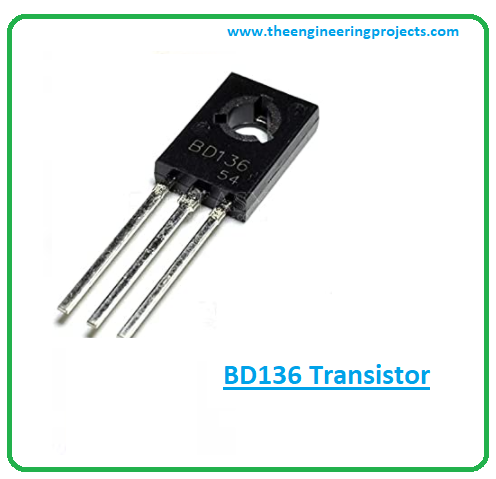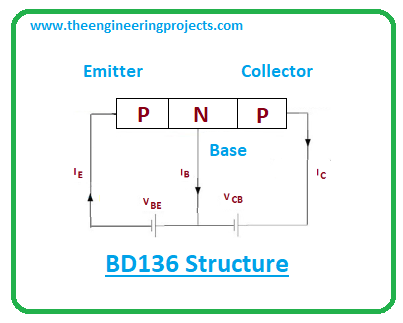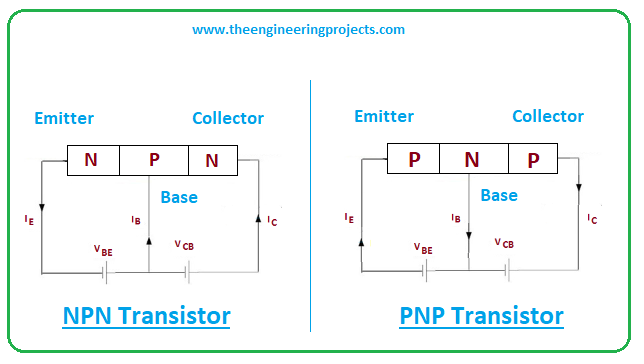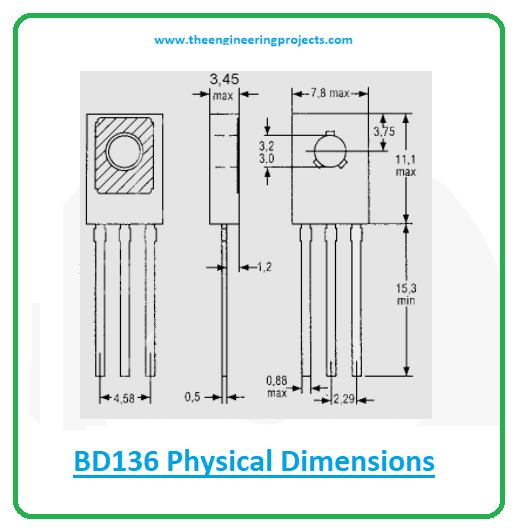
Introduction to BD136
- BD136 is a PNP general purpose transistor mainly used for switching and amplification purpose. It comes with three terminals named as emitter, collector and base.
- The small input current at the base pin is used to produce large output current at the other two terminals. This process is used for amplification purposes.
- It carries amplification factor or current gain 40 to 250, projecting the capacity of the component it can amplify the current.
- BD136 is composed of three layers where one is an n-doped layer and the other two are p-doped layers. The n-doped layer sits between the two p-doped layers.
- The n-layer represents the base pin while the other two layers represent emitter and collector respectively.

- Though both electrons and holes play a critical role in the conductivity, as this is a PNP transistor, here majority carriers are holes in contrast with NPN transistor where majority carriers are electrons.
- In both cases, the base pin is the main terminal responsible for the entire transistor action. The base pin behaves like a valve that controls the number of holes in PNP transistors and electrons in NPN transistors.
- It is important to note that NPN transistors are preferred over PNP transistors for amplification purposes because the electrons’ movement is better and quicker than the mobility of holes in PNP transistors.
BD136 Datasheet
- Before you embed this component in your project, it is wise to have a look at the datasheet of the component that helps you better understand the main characteristics of the transistor.
- Click the like below to download the datasheet of the BD136 transistor.
BD136 Pinout
BD136 comes with three main terminals known as: 1: Emitter 2: Collector 3: Base The following figure represents the pinout of the BD136 transistor.
- All these terminal can be connected with the electrical circuit. Also, these terminals are different in terms of doping concentrations and working ability.
- The base and collector terminals are less doped compared to the emitter terminal. Plus, emitter terminals holds the current of the entire transistor.
BD136 Working Principle
- The working principle of this PNP transistor is simple and straightforward and works like an NPN transistor. Also, in NPN transistor the base pin is positive while it’s negative in PNP transistor.
- The transistor is turned ON and both emitter and collector terminals are forward biased when there is no current at the base side.
- And when there is current at the base terminal, the transistor is turned OFF, projecting both collector and emitter sides are reverse biased.

- Recall NPN transistors are preferred over PNP transistors for amplification purposes because the electrons’ movement is better and quicker than the mobility of holes in the PNP transistor.
Difference between PNP and NPN transistors
- In both transistors, the base pin is the main terminal used to bias the transistor. The base terminal acts like a valve that controls the number of electrons in the NPN transistor and the number of holes in the PNP transistor.
- The main difference stands between the voltages polarities and the current direction. In PNP transistor current flows from emitter to collector terminals while in NPN transistor current flows from collector to emitter terminal.

- Keep this thing in mind, both NPN and PNP transistors are interchangeable only if a bipolar junction transistor is composed of two back-to-back diodes with the base terminal being the common terminal.
BD136 Power Ratings
The following table represents the absolute maximum ratings of BD136.| Absolute Maximum Ratings BD136 | ||||
|---|---|---|---|---|
| No. | Rating | Symbol | Value | Unit |
| 1 | Collector-Emitter Voltage | Vce | 45 | V |
| 2 | Collector-Base Voltage | Vcb | 45 | V |
| 3 | Emitter-Base Voltage | Veb | 5 | V |
| 4 | Collector Current | Ic | 1.5 | A |
| 5 | Current Gain | hfe | 40 to 250 | |
| 6 | Power Dissipation | Ptot | 12 | W |
| 7 | Storage Temperature | Tstg | -55 to 150 | C |
- The collector-base and collector-emitter voltages are 45V respectively. While emitter-base voltage is 5V indicating only 5V is used to bias the transistor.
- The amplification factor ranges from 40 to 250, demonstrating the transistor capacity to amplify the input signal. The collector current is 1.5A, which means it is capable to support loads under 1.5A.
- The power dissipation is 12 W and storage temperature is -55 to 150C.
- It is important to note that these are defined as the stress ratings. While working with your project, make sure the ratings don’t surpass the absolute maximum ratings, else they can damage the component and thus the entire project.
- Plus, if you apply these ratings for more than the desired time, they can affect device reliability.
BD136 Alternatives
The following are the alternatives to BD136.- TIP127
- TIP42
- BC157
- 2N3906
- BC556
- BD140
- 2SA1943
- S8550
- While incorporating alternatives into your electrical project, check the pinout of the alternatives. As it’s quite likely the pinout of the alternatives might differ from the pinout of BD136.
BD136 Applications
BD136 is used in the following applications.- Used for switching and amplification purpose.
- Used to drive loads under 1.5A.
- Used for constructing Astable bistable multivibrators.
- Used in current mirror circuits.
- Used in comparator and oscillator circuits.
- Employed for impedance buffering.
- Used to drive loads under 1.5A.
- Incorporated in H- Bridge circuits.
BD136 Physical dimensions
The following figure shows the physical dimensions of the component BD136.



